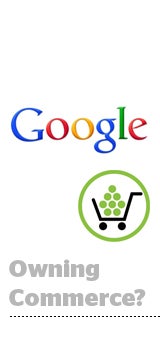 Google’s product listing ads (PLAs) have positioned it for a strong holiday season, possibly at the expense of Amazon.
Google’s product listing ads (PLAs) have positioned it for a strong holiday season, possibly at the expense of Amazon.
Based on data compiled in the third quarter, search and digital marketing agency RKG found that among 500 online retail clients, Google search spending increased 18% year over year. In Q3 alone, Google PLAs drove 35% of nonbrand search clicks.
Similarly, Mercent has seen a marked uptick in adoption and ROI on media spend for these ad units. Mercent syndicates ads, product detail pages, real-time pricing and inventory data for 550 retail brands across Google, Amazon, eBay, Pinterest and major retargeters ranging from TellApart to MediaForge.
A bit of history: In June 2012, Google shifted its free product listings to a pay-for-performance model. Product listing ads, defined by Google as search ads that include richer product information like images, price and merchant, are charged on a cost-per-click or conversion-based CPA percentage basis.
“Pre-June 2012, Google was pretty volatile, but tended to average out at around a 35-40% year-over-year growth range,” said Eric Best, CEO of Mercent. “Not surprisingly, we saw a severe drop-off in gross merchandise value coming from Google after they switched to the paid model.”
Companies began to aggressively test “large, material PLA budgets” beginning in September and October of last year, according to Best.
“We saw year-over-year growth for Google Shopping [the PLA program is a part of it] measured against the volume we’d seen from the free Google product search program the year prior recover to that 30-40% growth range,” he said.
A Surge For Google Shopping
After a moderate 20% growth rate in Q1 2013, Google Shopping has “exploded” in the last six months. Mercent has managed PLAs alongside paid search; they’ve been a higher performer than AdWords on a dollar-for-dollar basis for retail advertisers, Best said.
“In April, May and June, we were running in the 50% year-over-year growth range,” Best said. Then in July, revenue from PLAs jumped again. “Across all of our sellers who were active on Google product search in July through September 2012, Google is now generating twice as much revenue for those retailers this year, in spite of the shift to the paid program.”
The Mercent data suggests consumer momentum for Google Shopping. When measuring client results (who were active on both Amazon and Google Shopping), the average order value on Google Shopping was $115 as opposed to Amazon’s $57.
AdExchanger Daily
Get our editors’ roundup delivered to your inbox every weekday.
Daily Roundup
These findings are reflected in Google’s overall budget impact. In a report drafted by Jefferies’ analysts Brian Pitz and Brian Fitzgerald, Google PLAs saw a 54.7% quarterly increase in adoption last quarter among 10,000 US advertisers.
On Google’s Q3 earnings call, the company outlined plans to provide a “seamless purchasing experience,” including helping traditional retail merchants utilize their payment solutions, such as Google Wallet for mobile.
Google In-Store?
Here’s where it gets really interesting: Google three weeks ago launched local product listing ads to a select number of beta merchants, which through integrations with local store inventory allows advertisers to surface mobile-specific ads with “real-time product availability, pricing and promotions at the store level,” Best noted. “It’s clear they are betting on this in-store shopping use case in terms of where they’re focusing their innovation in the ad products they provide.”
Brick-and-mortar stores increasingly look to digital influence as an indicator of in-store performance, according to Howard Davidowitz, chairman of Davidowitz & Associates Inc., a national retail consulting and investment-banking firm based in New York. “It’s a critical thing,” he said, calling out the influence of online research on in-store purchases. Target and Staples, too, have ramped up their digitally influenced purchase strategy by letting consumers pick up in store this holiday season when shopping online.
Electronics brand Lenovo, according to Mobile Commerce Daily, reportedly tapped Google Maps and local retail merchants to offer discounts through display ads to consumers making mobile search queries. Those discounts were carried through to Lenovo’s own site or nearby stores where they could make a purchase of inventory that was in stock locally.
“Google believes that the first, easiest dollar to make is by converting offline advertising to digital advertising in scenarios where the shopper is still in a physical store,” Best said. “There’s plenty of leg room there if Google can take a small portion of that $2 trillion in digitally influenced offline shopping. I’ll caveat that with one thing: The one thing Google cannot afford to do online is lose search dominance in online retail.”
Forrester Research came out with a report last July that found some 30% of online shoppers begin their research process on Amazon, to Google’s 13%. Google seems to have stepped up its commerce play, since, launching Google Express delivery in select markets this fall.
As Forrester analyst JP Gownder outlined in a blog post this fall, Google is not content sitting on the sidelines in commerce – be it brick-and-mortar retail, delivery or the dominion of ecommerce where Amazon has long reigned.
“Who knows more about you than Google?” he writes. “Google can ride a variety of waves to mine your personal information to (literally) point you to the right areas of its stores. Using location-based technologies, it can create in-store experiences that consumers have never seen before. Google can change the large screen displays you walk by in store – a la Minority Report – to personalize your visit.”
“Amazon, I think, is really betting on ecommerce growth at the expense of brick-and-mortar purchases,” Best noted. “The two companies are pursuing different strategies. It’s understandable why Google is investing so heavily in shopping – to maintain dominance in that retail search market position is critical to their ongoing success and growth.”














